Zhang Chiahou's Blog, page 8
July 31, 2020
India police patrol ahead of construction of temple on bitterly contested site
LUCKNOW, India (Reuters) – Police have been ordered onto the streets of an Indian town where Hindu groups will next week begin building a temple on a site contested by Muslims for decades in a dispute that has sparked some of the country’s most bloody communal violence.
FILE PHOTO: A general view of Ayodhya is seen after Supreme Court’s verdict on a disputed religious site, India, November 10, 2019. REUTERS/Danish Siddiqui
The Supreme Court of India ruled last year that Hindus, who believe the site in the northern town of Ayodhya is the birthplace of Lord Ram, a physical incarnation of the Hindu god Vishnu, be allowed to build a temple there.
Hindus say the site was holy for them long before the Muslim Mughals, India’s most prominent Islamic rulers, built the Babri Mosque there in 1528. The court said Muslims be given another plot of land for a mosque.
Prime Minister Narendra Modi, whose ruling Bharatiya Janata Party campaigned for more than three decades for the temple, has been invited to lay the temple’s foundation stone on Aug. 5, officials said.
“But his visit depends on the pandemic situation and security concerns around it,” said a senior official in Modi’s office in New Delhi, referring to the novel coronavirus.
“Social distancing rules will be followed,” said the official, who declined to be identified as he is not an authorised spokesman.
In 1992, a Hindu mob destroyed the 16th-century mosque on the site, triggering riots in which about 2,000 people, most of them Muslims, were killed across the country.
Court battles over the ownership of the site followed.
Since the court ruling last year, tension has eased and Muslims, who make up about 12% overwhelmingly Hindu India, have largely accepted the decision.
“We’ve accepted that Hindu temple will be built and there’s no point in creating tension,” said Shakib Noor, a member of a Muslim religious board in Ayodhya
Nevertheless, authorities in Ayodhya have ordered police to patrol the streets and for barricades to be set up to prevent big crowds gathering next week.
While India has ended its most coronavirus restrictions, it has maintained a ban on religious gatherings.
Donations for the temple have poured in from Hindus in India and abroad. It should be finished by 2022, its supporters say.
“This is a great moment for the entire Hindu community,” said Sharad Sharma, a senior member of Vishwa Hindu Parishad, a hardline Hindu group involved in the temple’s construction.
Source: Reuters
July 30, 2020
India and China race to build along a disputed frontier
 Image caption India is building a number of roads and bridges in the Ladakh region
Image caption India is building a number of roads and bridges in the Ladakh regionIndia and China are trying to out-build each other along their disputed Himalayan border.
A new road to a high-altitude Indian forward air base is said to have been one of the main triggers for a clash with Chinese troops last month that left at least 20 Indian soldiers dead.
The 255km (140-mile) Darbuk-Shyok-Daulat Beg Oldi (DSDBO) road – which winds through mountain passes up to the world’s highest airstrip more than 5,000m above sea level in the Ladakh region – was finished last year after nearly two decades of work. Its completion could increase India’s ability to move men and materiel rapidly in a conflict.
The 15 June clash, in Ladakh’s Galwan Valley, gave rise to concerns that tensions between the two nuclear powers could boil over. They have never agreed on the exact position of their 3,500km border, and their armies – two of the world’s largest – come face-to-face at many points along the rough, inhospitable terrain.
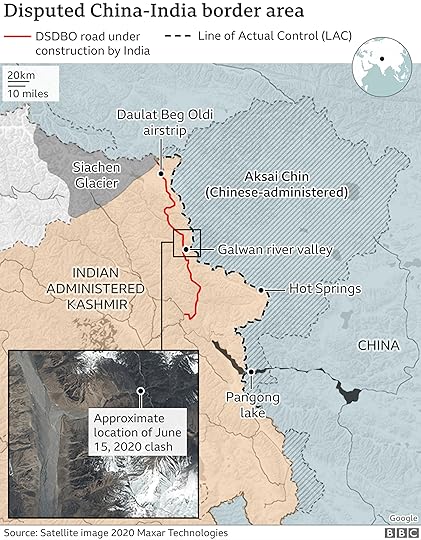

Both India and China have devoted money and manpower to building roads, rail links and airfields along the Line of Actual Control (LAC) – the de facto boundary separating them – as well as modernising their military hardware in the region.
India’s recent building work, including the DSDBO road, appears to have infuriated China – but China has been busy building along the border for years. Both sides tend to view the other’s construction efforts as calculated moves to gain tactical advantage, and tensions flare when either announces a major project.
In the summer of 2017, the neighbours were brought to a stand-off at Doklam plateau, far to the east of Ladakh. That confrontation was also over construction – this time China attempting to extend a border road near a tri-junction between India, China and Bhutan.
India plays catch-up
The completion of the DSDBO road, which connects the crucial Daulat Beg Oldi airstrip – put back in use in 2008 – to the regional capital Leh, has strengthened India’s ability to move equipment quickly. The all-weather road lies about 20km from the Karakoram Pass and runs parallel to the LAC in eastern Ladakh.
India has long stationed men at Daulat Beg Oldi but, before the reactivation of the airstrip and the completion of the road, the men there could get supplies only through helicopter drops, and nothing could be removed, turning the airstrip into a “graveyard for equipment”.
Additional roads and bridges are now being built to link the road with inland supply bases and border outposts on the LAC, enabling Indian patrols to go further forward and shifting the tactical dynamics in the area.
 Image caption India has landed heavy transport planes at the world’s highest airstrip, Daulat Beg Oldi
Image caption India has landed heavy transport planes at the world’s highest airstrip, Daulat Beg OldiDespite the recent clashes, India has signalled that it will continue improving its infrastructure. It is in the process of moving 12,000 workers from its eastern state of Jharkhand to build roads along the border in Ladakh, Himachal Pradesh and Uttarakhand, all areas which border China.
After years of letting its infrastructure fall into neglect, India is frantically trying to develop its borderlands to neutralise China’s logistical advantage. It has begun a vast road and railway construction programme in the region.


A total of 73 strategic roads and 125 bridges have been sanctioned along different sectors on the Indian side of the LAC. But progress has been slow. Only 35 roads have been finished so far – key among them are Ghatibagarh-Lipulekh in Uttarakhand state and Damping-Yangtze in Arunachal Pradesh. Another 11 are scheduled to be built by the end of this year.
Delhi has also approved nine “strategic” rail lines – including the Missamari-Tenga-Tawang and the Bilaspur-Mandi-Manali-Leh sections. These run along the border with China and would allow the Indian military to carry heavy armour into position.
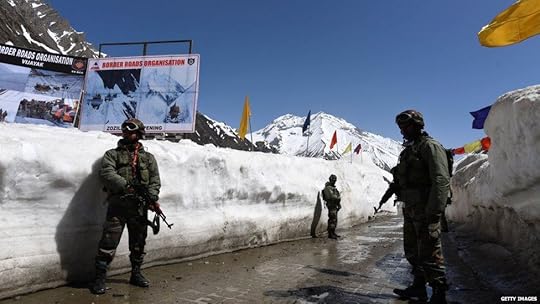 Image caption India has expedited the construction of roads along its border with China
Image caption India has expedited the construction of roads along its border with ChinaIn terms of aviation facilities, India has about 25 airfields along the LAC but its recent focus has been on expanding its network of Advanced Landing Grounds (ALGs).
In 2018, India announced that it would modernise eight existing ALGs and also develop seven new ones close to the border. Sukhoi-30 advanced fighter jets and Chetak helicopters are deployed at Chabua – a key Indian Air Force base located in the state of Assam, along the eastern section of the border with China. That base has been recently renovated and modernised.
INTERACTIVEIndia is continuing to expand capacity at the Chabua Air Force Station in Assam, close to its disputed territory with China near Arunachal Pradesh
9 July 2020

27 October 2018


Although improved in recent years, India’s building efforts continue to be hampered by rugged terrain, land acquisition problems, bureaucratic delays and budget constraints.
And it has a lot of catching up to do.
China’s head-start
China has been putting its renowned construction abilities to use in recent years by building a network of air bases, cantonments and other physical infrastructure along the frontier.
Beijing began building roads in the Himalayan region as early as the 1950s, and now has an extensive road and rail network in Tibet and Yunnan Province.
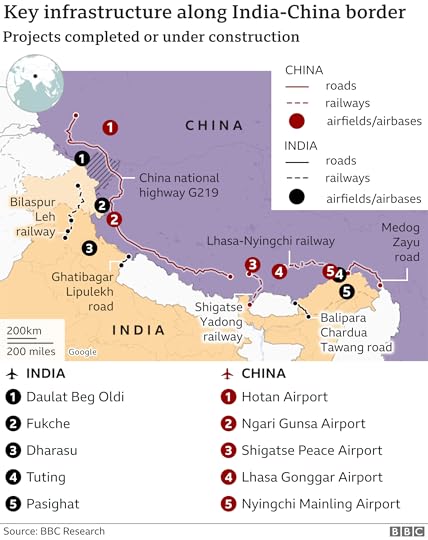

Since 2016, China has upped the stakes by increasing connectivity to areas near its boundary with India, Bhutan and Nepal.
It is working on linking the old Xinjiang-Tibet Road to National Highway G219, which runs along almost the entire China-India border. A concrete road between Medog and Zayu near India’s Arunachal Pradesh state – which China claims – will be completed by the end of this year.

You might also be interested in:
Satellite images ‘show China structures’ on India borderChina and India face off on the roof of the worldAn extraordinary escalation ‘using rocks and clubs’A freezing, inhospitable battlefield on a mountain

There is also a new rail line under construction connecting Shigatse – the second largest city in Tibet – to Chengdu via Nyingchi, close to the Indian border.
Another rail link is planned between Shigatse and Yadong, a trading centre next to Sikkim, a Himalayan state in north-east India, where a skirmish took place between Indian and Chinese troops in early May.
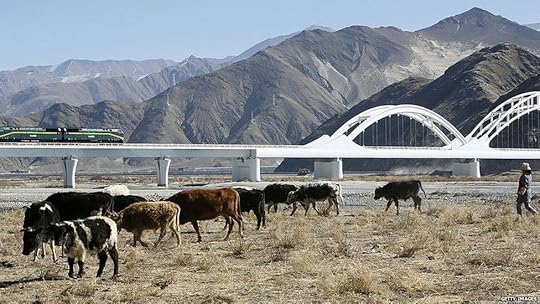 Image caption China has built high-speed rail lines in Tibet despite the treacherous terrain
Image caption China has built high-speed rail lines in Tibet despite the treacherous terrainChina has around a dozen airfields facing India, with five of them being dual-use airports in Tibet, meaning for both civilian and military purposes.
It is building three new airports there and upgrading Shigatse, Ngari Gunsa and Lhasa’s all-weather Gonggar airport by adding underground shelters and new runways.
A surface-to-air missile battery and advanced fighter jets are reportedly deployed at Ngari Gunsa airfield, which is located 4,274m (14,022) feet above sea level, about 200km from Pangong Lake.
INTERACTIVEThe high altitude Ngari Gunsa airfield has received a significant upgrade in recent months with the construction of new taxiway and parking ramps.
2 July 2020

26 March 2020


In terms of air power, military experts say India has a relative advantage, as China’s bases are generally further from the LAC and at higher altitudes, where the thinner air means jets can carry less fuel and payload.
Suspicions over border infrastructure
These infrastructure improvements on both sides are designed with one primary purpose – to allow the fast movement of troops and military hardware to the border in case of a full-scale conflict.
“When these ambitious infrastructure projects eventually are completed, large numbers of Indian forces will be able to move more freely within certain critical sub-theatres without fear of being crippled or physically blocked,” noted a 2019 study by the Centre for a New American Security.


India long held back from extensive development, believing that improving infrastructure on its side of the border would facilitate Chinese movement inside Indian territory in the event of a conflict. But it is moving away from that reasoning.
The two countries have fought only one war, in 1962, when India suffered a humiliating defeat.
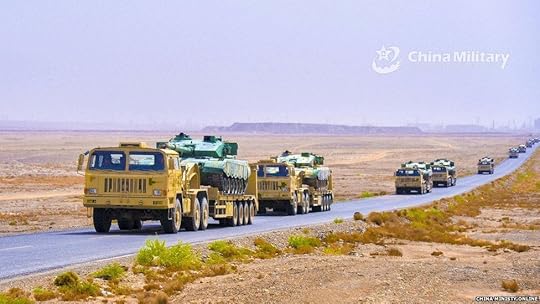 Image caption China showcased its logistics capability during a recent military drill
Image caption China showcased its logistics capability during a recent military drillRajeswari Pillai, a fellow at Observer Research Foundation, described India’s infrastructure building as “primarily a defensive response because China’s infrastructure represents a threat, as it can permit the Chinese army to engage in offensive operations and allows it to rapidly concentrate forces at any point where there is a dispute”.
“India’s poor infrastructure has meant that it has always had difficulties in defending against China’s encroachments,” Ms Pillai said.

You might also be interested in:
New images show Doklam plateau build-upBorder clash a ‘deliberate provocation’ – ChinaThe fake news about India and China’s border clash

China denies encroaching, as does India when it is accused of stepping over the line. Several rounds of talks in the last three decades have failed to resolve the boundary disputes.
Meanwhile, Chinese state media has highlighted how quickly the military was able to mobilise for a recent drill near the India border using their efficient transport networks.


“The scale and short time it took to finish the mobilisation showed the army has the capability to project its power anywhere in China very quickly and send reinforcements to remote locations, including high elevation,” an unnamed Chinese army veteran told the state-run Global Times.
As vast numbers of new roads, railways and bridges appear on both sides of the border, there is plenty of scope for more face-offs between Indian and Chinese troops in the future.
BBC Monitoring reports and analyses news from TV, radio, web and print media around the world. You can follow BBC Monitoring on Twitter and Facebook. Graphics by the BBC Visual Journalism team.
Source: The BBC
India extends bid submission deadline for stake in Bharat Petroleum to September 30
FILE PHOTO: A man paints the logo of oil refiner Bharat Petroleum Corp (BPCL) on a wall on the outskirts of Kochi, India, November 21, 2019. REUTERS/Sivaram V
MUMBAI (Reuters) – India’s finance ministry said Wednesday it had extended the deadline for submission of bids for the sale of its stake in oil refiner Bharat Petroleum Corp Ltd (BPCL.NS) to Sept. 30, allowing more time for interested parties.
It was extended “in view of further requests from the interested bidders and the prevailing situation arising out of COVID-19,” the ministry said in a statement, marking the second such extension since May.
India has the world’s third-highest caseload of coronavirus infections after the United States and Brazil, and a strict lockdown imposed in March has been eased in parts in recent weeks but economic activity is far from a full restart.
The government’s move to sell its 52.98% stake in Bharat Petroleum, the country’s second-biggest oil refiner, could help it bridge its widening fiscal gap. Oil minister Dharmendra Pradhan said last November that international energy firms were set to take part in the bidding process.
Source: Reuters
July 29, 2020
Special Report: Rite Aid deployed facial recognition systems in hundreds of U.S. stores
(Reuters) – Over about eight years, the American drugstore chain Rite Aid Corp (RAD.N) quietly added facial recognition systems to 200 stores across the United States, in one of the largest rollouts of such technology among retailers in the country, a Reuters investigation found.https://queso-cdn.prod.reuters.
In the hearts of New York and metro Los Angeles, Rite Aid deployed the technology in largely lower-income, non-white neighborhoods, according to a Reuters analysis. And for more than a year, the retailer used state-of-the-art facial recognition technology from a company with links to China and its authoritarian government.
In telephone and email exchanges with Reuters since February, Rite Aid confirmed the existence and breadth of its facial recognition program. The retailer defended the technology’s use, saying it had nothing to do with race and was intended to deter theft and protect staff and customers from violence. Reuters found no evidence that Rite Aid’s data was sent to China.
Last week, however, after Reuters sent its findings to the retailer, Rite Aid said it had quit using its facial recognition software. It later said all the cameras had been turned off.
“This decision was in part based on a larger industry conversation,” the company told Reuters in a statement, adding that “other large technology companies seem to be scaling back or rethinking their efforts around facial recognition given increasing uncertainty around the technology’s utility.”
Reuters pieced together how the company’s initiative evolved, how the software has been used and how a recent vendor was linked to China, drawing on thousands of pages of internal documents from Rite Aid and its suppliers, as well as direct observations during store visits by Reuters journalists and interviews with more than 40 people familiar with the systems’ deployment. Most current and former employees spoke on condition of anonymity, saying they feared jeopardizing their careers.
While Rite Aid declined to disclose which locations used the technology, Reuters found facial recognition cameras at 33 of the 75 Rite Aid shops in Manhattan and the central Los Angeles metropolitan area during one or more visits from October through July.
The cameras were easily recognizable, hanging from the ceiling on poles near store entrances and in cosmetics aisles. Most were about half a foot long, rectangular and labeled either by their model, “iHD23,” or by a serial number including the vendor’s initials, “DC.” In a few stores, security personnel – known as loss prevention or asset protection agents – showed Reuters how they worked.
The cameras matched facial images of customers entering a store to those of people Rite Aid previously observed engaging in potential criminal activity, causing an alert to be sent to security agents’ smartphones. Agents then reviewed the match for accuracy and could tell the customer to leave.
Rite Aid told Reuters in a February statement that customers had been apprised of the technology through “signage” at the shops, as well as in a written policy posted this year on its website. Reporters found no notice of the surveillance in more than a third of the stores they visited with the facial recognition cameras.
Among the 75 stores Reuters visited, those in areas that were poorer or less white were much more likely to have the equipment, the news agency’s statistical analysis found.
Stores in more impoverished areas were nearly three times as likely as those in richer areas to have facial recognition cameras. Seventeen of 25 stores in poorer areas had the systems. In wealthier areas, it was 10 of 40. (Ten of the stores were in areas whose wealth status was not clear. Six of those stores had the equipment.)
In areas where people of color, including Black or Latino residents, made up the largest racial or ethnic group, Reuters found that stores were more than three times as likely to have the technology.
Reuters’ findings illustrate “the dire need for a national conversation about privacy, consumer education, transparency, and the need to safeguard the Constitutional rights of Americans,” said Carolyn Maloney, the Democratic chairwoman of the House oversight committee, which has held hearings on the use of facial recognition technology.
Rite Aid said the rollout was “data-driven,” based on stores’ theft histories, local and national crime data and site infrastructure.
Cathy Langley, Rite Aid’s vice president of asset protection, said earlier this year that facial recognition – which she referred to as “feature matching” – resulted in less violence and organized crime in the company’s stores. Last week, however, Rite Aid said its new leadership team was reviewing practices across the company, and “this was one of a number of programs that was terminated.”
RELATED COVERAGE
How Reuters analyzed Rite Aid’s use of facial recognition technology
‘ORWELLIAN SURVEILLANCE’
Facial recognition technology has become highly controversial in the United States as its use has expanded in both the public and private sectors, including by law enforcement and retailers. Civil liberties advocates warn it can lead to harassment of innocent individuals, arbitrary and discriminatory arrests, infringements of privacy rights and chilled personal expression.
Adding to these concerns, recent research by a U.S. government institute showed that algorithms that underpin the technology erred more often here when subjects had darker skin tones.
Facial recognition systems are largely unregulated in the United States, despite disclosure or consent requirements, or limits on government use, in several states, including California, Washington, Texas and Illinois. Some cities, including San Francisco, ban municipal officials from using them. In general, the technology makes photos and videos more readily searchable, allowing retailers almost instantaneous facial comparisons within and across stores.
Among the systems used by Rite Aid was one from DeepCam LLC, which worked with a firm in China whose largest outside investor is a Chinese government fund. Some security experts said any program with connections to China was troubling because it could open the door to aggressive surveillance in the United States more typical of an autocratic state.
U.S. Senator Marco Rubio, a Florida Republican and acting chair of the U.S. Senate’s intelligence committee, told Reuters in a statement that the Rite Aid system’s potential link to China was “outrageous.” “The Chinese Communist Party’s buildup of its Orwellian surveillance state is alarming, and China’s efforts to export its surveillance state to collect data in America would be an unacceptable, serious threat,” he said.
The security specialists expressed concern that information gathered by a China-linked company could ultimately land in that government’s hands, helping Beijing to refine its facial recognition technology globally and monitor people in ways that violate American standards of privacy.
“If it goes back to China, there are no rules,” said James Lewis, the Technology Policy Program director at the Washington-based Center for Strategic and International Studies.
Asked for comment, China’s Ministry of Foreign Affairs said: “These are unfounded smears and rumors.”
‘A PROMISING NEW TOOL’
Rite Aid, afflicted with financial losses in recent years, is not the only retailer to adopt or explore facial recognition technology.
Two years ago, the Loss Prevention Research Council, a coalition founded by retailers to test anti-crime techniques, called facial recognition “a promising new tool” worthy of evaluation.
“There are a handful of retailers that have made the decision, ‘Look, we need to leverage tech to sell more and lose less,” said council director Read Hayes. Rite Aid’s program was one of the largest, if not the largest, in retail, Hayes said. The Camp Hill, Pennsylvania-based company operates about 2,400 stores around the country.
The Home Depot Inc (HD.N) said it had been testing facial recognition to reduce shoplifting in at least one of its stores but stopped the trial this year. A smaller rival, Menards, piloted systems in at least 10 locations as of early 2019, a person familiar with that effort said.
Walmart Inc (WMT.N) has also tried out facial recognition in a handful of stores, said two sources with knowledge of the tests. Walmart and Menards had no comment.
Using facial recognition to approach people who previously have committed “dishonest acts” in a store before they do so again is less dangerous for staff, said Rite Aid’s former vice president of asset protection, Bob Oberosler, who made the decision to deploy an early facial recognition system at Rite Aid. That way, “there was significantly less need for law enforcement involvement,” he said.
‘TOUGHER’ NEIGHBORHOODS
In interviews, 10 current and former Rite Aid loss prevention agents told Reuters that the system they initially used in stores was from a company called FaceFirst, which has been backed by U.S. investment firms.
It regularly misidentified people, all 10 of them said.
“It doesn’t pick up Black people well,” one loss prevention staffer said last year while using FaceFirst at a Rite Aid in an African-American neighborhood of Detroit. “If your eyes are the same way, or if you’re wearing your headband like another person is wearing a headband, you’re going to get a hit.”
FaceFirst’s chief executive, Peter Trepp, said facial recognition generally works well irrespective of skin tone, an issue he said the industry addressed years ago. He declined to talk about Rite Aid, saying he would not discuss any possible clients.
Rite Aid originally piloted FaceFirst at its store on West 3rd Street and South Vermont Avenue in Los Angeles, a largely Asian and Latino neighborhood, around 2012.
Of the 65 stores the retailer targeted in its first big rollout, 52 were in areas where the largest group was Black or Latino, according to Reuters’ analysis of a Rite Aid planning document from 2013 that was read aloud to a reporter by someone with access to it. Reuters confirmed that some of these stores later deployed the technology but did not confirm its presence at every location on the list.
Separately, two former Rite Aid managers and a third source familiar with the FaceFirst rollout said the systems were concentrated, respectively, in the “tougher,” “toughest” or “worst” areas.
Reuters reviewed a 2016 spreadsheet from the company’s asset protection unit in which Rite Aid rated 20 higher-earning Manhattan stores as having equal risk of loss – labeled “MedHigh.” Two of 10 stores where whites were the largest racial group had facial recognition technology when Reuters visited this year, whereas eight of the 10 in non-white areas had the systems.
One spot ranked “MedHigh” was a store at 741 Columbus Avenue in New York’s whiter, wealthier Upper West Side. Another was the pharmacy’s West 125th Street store in nearby Harlem, a majority African-American neighborhood. The Harlem store got facial recognition technology; the Upper West Side one did not, as of July 9.
(See graphics here here and here here and here tmsnrt.rs/2EpMRhF?scatter=true)
‘LOOKS NOTHING LIKE ME’
Starting in 2013, as Rite Aid deployed FaceFirst’s technology in Philadelphia, Baltimore and beyond, some serious drawbacks emerged, current and former security agents and managers told Reuters.
For instance, the system would “generate 500 hits in an hour all across the United States” when photos in the system were blurry or taken at an odd angle, one of the people familiar with FaceFirst’s operations said.
FaceFirst’s Trepp said the company has high accuracy rates while running “over 12 trillion comparisons per day without any known complaints to date.”
During that earlier period, Tristan Jackson-Stankunas said Rite Aid wrongly fingered him as a shoplifter in a Los Angeles store based on someone else’s photo. While Reuters could not confirm the method Rite Aid used to identify him, the store had FaceFirst technology by that time, according to a Rite Aid security agent and a Foursquare review photo showing the camera.
According to a complaint Jackson-Stankunas filed with the California Department of Consumer Affairs a week after the incident, he was looking for air freshener in September 2016 when a manager ordered him to leave the store. The manager said he had received a security image of Jackson-Stankunas taken at another Rite Aid in 2013 from which he allegedly had stolen goods, according to the complaint.DeepCam security cameras monitor shoppers inside a Rite Aid store in New York City, New York, U.S., June 25, 2020. REUTERS/Lucas Jackson
When Jackson-Stankunas viewed the photo on the manager’s phone, he told Reuters, he saw nothing in common with the person except their race: Both are Black.
“The guy looks nothing like me,” said Jackson-Stankunas, 34, who ultimately was allowed to make his purchase and leave the store. Rite Aid “only identified me because I was a person of color. That’s it.”
The California department told him his complaint fell outside its purview, directing him to another state office, email records show. Instead, he said he decided to write the store a bad review on Yelp.
Rite Aid and the manager who allegedly was involved declined to comment on Jackson-Stankunas’ account.
At one store Reuters visited, a security agent scrolled through FaceFirst “alerts” showing a number of cases in which faces were obviously mismatched, including a Black man mixed up with someone who was Asian. Reuters could not determine whether the incorrect matches resulted in confrontations with customers.
FaceFirst CEO Trepp said that his company takes racial bias seriously and would not work with any business that disregarded civil rights. “We cannot stand for racial injustice of any kind, including in our technology,” he said.
Generally, Trepp said, Reuters’ findings about his company contained “extensive factual inaccuracies” and are “not based upon information from credible sources.”
A NEW SYSTEM
Early in 2018, Rite Aid began installing technology from DeepCam LLC, ultimately phasing out FaceFirst in stores around the country, interviews with Rite Aid loss prevention agents and internal vendor documents indicate.
Six security staffers who used both systems said DeepCam’s matches were more accurate – sometimes to a fault. The technology picked up faces from ads on buses or pictures on T-shirts, three said. One famous face captured in DeepCam was Marilyn Monroe’s, one of the agents said.
At least until 2017, FaceFirst had employed an older method of biometric identification that compared maps of subjects’ faces, two people familiar with its system said. Only later did it move over to software based on “artificial intelligence” like DeepCam’s. Though the data and algorithms differ by brand, these systems draw upon potentially millions of samples to “learn” how to match faces.
DeepCam cameras photographed and took live video of every person entering a Rite Aid store, aiming to create a unique facial profile, Rite Aid agents said. If the customer walked in front of another DeepCam facial recognition camera at a Rite Aid shop, new images were added to the person’s existing profile. Two agents said they lost access to the images after 10 days unless the person landed on a watch list based on their behavior in stores.
When agents saw someone commit a crime – or just do something suspicious, one said – they scrolled through profiles on their smartphone to search for the individual, only adding the person to the watch list with a manager’s approval. The next time the shopper walked into a Rite Aid that had the technology, agents received a phone alert and checked the match for accuracy. Then they could order the person to leave, agents told Reuters.
Rite Aid said adding customers to the watch list was based on “multiple layers of meaningful human review.” The company told Reuters its procedures ensured customers were not confronted unnecessarily.
If a person was found to be engaging in criminal behavior, Rite Aid said, “we retain the data as a matter of policy to cooperate in pending or potential criminal investigations.”
Other U.S. retail stores have tried DeepCam. Independent 7-Eleven franchise owners in Virginia told Reuters they conducted trials of the software starting in 2018 and later dropped it. They said they largely found the system accurate but not user friendly and too expensive to maintain. The system was advertised online as costing $99 a month.
7-Eleven Inc did not answer requests for comment.
THE CHINA CONNECTION
The two founding owners of U.S.-based DeepCam LLC were Don Knasel and Jingfeng Liu, who set up the firm in Longmont, Colorado, in 2017, state records show. Liu’s residential address in Longmont was listed as its headquarters.
A Chinese native with U.S. citizenship and a doctorate from Carnegie Mellon University, Liu had the skills to do business in both the United States and China.
According to China’s official business registration records, he is chairman of another facial recognition firm in China called Shenzhen Shenmu Information Technology Co Ltd, whose website is DeepCam.com.
For a time, the U.S.-based DeepCam LLC and Shenzhen Shenmu were closely connected: In addition to Liu’s role in both companies, they shared the same website and email accounts, according to internal records seen by Reuters.
Internal correspondence reviewed by Reuters suggests that DeepCam reached a deal with Rite Aid by March 2018, when a colleague emailed Knasel to congratulate him. Internal records also indicated that China-based Shenzhen Shenmu helped its American counterpart with product development and that Liu was expected to pay at least some of the bills. That same month, a U.S. executive wrote: “Hi Jingfeng- Thanks for the credit card. Here is the receipt for the Indianapolis Trade Show.”
In an interview, Liu confirmed the financing, saying of Knasel: “Whenever he needed money, I give him some money.” Liu said Knasel told him about the Rite Aid project but left him in the dark about the business. Knasel “never let data cross between the two countries,” Liu said.
As the Rite Aid rollout proceeded in 2018, correspondence among DeepCam staff, seen by Reuters, expressed concerns about publicly revealing any links to China, as well as using the term “facial recognition” in the U.S. market for fear of attracting the attention of the American Civil Liberties Union.
Days after the ACLU wrote a March 2018 blog post here critical of retailers’ suspected use of the technology, including Rite Aid’s, Knasel emailed staff: “It looks like the ACLU may be starting to stick its head up….We need to tone down facial recognition, which I have tried to do….If they come after us, we are dead….so we have to avoid.” The punctuation in the message is Knasel’s.
Jay Stanley, the ACLU senior policy analyst who co-authored the blog post, told Reuters that the right response to civil liberties concerns about surveillance technology “is not to start using it in secret.”
It is “to stop using the technology altogether. We are glad Rite Aid seems to have ultimately recognized this.”
Today, both Liu and Knasel say no ties exist between the U.S. and Chinese businesses.
“We never do any business in USA,” Liu wrote in a brief email to Reuters in March. “We focus in China market.”
More recently, in an interview and an email, Liu said he had not spoken with Knasel for more than a year and, to his disappointment, had not benefited from the U.S. venture.
In a statement to Reuters, Knasel sought to distance himself from Liu, Shenzhen Shenmu and DeepCam.
He did not address questions about DeepCam’s deal with Rite Aid. DeepCam, he said, is “winding up” its operations and now has no assets. He added that DeepCam never supplied China-based Shenzhen Shenmu with any data.
In February, Rite Aid told Reuters that DeepCam had been “re-branded” as pdActive. PdActive is a facial recognition company run by Knasel, who said it is not a rebranding of DeepCam but a different company that has no owners who are Chinese citizens.Slideshow (7 Images)
Knasel remained connected to DeepCam through another company he runs, dcAnalytics, which Knasel said licensed DeepCam’s technology until November 2019. Since then, Knasel said, U.S.-based dcAnalytics has been using “proprietary” technology, as well as facial recognition cameras purchased from DeepCam.
Knasel said dcAnalytics is “committed to upholding the highest standards possible to make sure facial recognition technology is used fairly, properly and responsibly.”
SENSITIVE QUESTIONS
Steve Dickinson, a Seattle attorney who practiced law in China for more than a decade and writes about cybersecurity, said geopolitical tensions have added sensitivity to any work Chinese surveillance firms do in the United States.
Last year, the U.S. government blacklisted several Chinese companies – including Hikvision (002415.SZ), one of the biggest surveillance camera manufacturers globally – alleging involvement in human rights abuses. China has deployed facial recognition cameras widely within its borders, providing a level of monitoring unfathomable to many Americans.
At the time, a U.S. Hikvision spokesman said the firm “strongly opposes” the decision and that punishing Hikvision would harm its U.S. business partners and discourage global companies from communicating with the U.S. government.
Liu described his company as nothing like the Chinese video surveillance giants. With about 20 employees, he said, it is “a tiny company pretending to be big,” struggling unsuccessfully to get government contracts and nearly bankrupt.
Reuters found that he and his company have financial and other ties to the Chinese government, however.
Most notably, Shenzhen Shenmu’s largest outside investor, holding about 20% of its registered capital, is a strategic fund set up by the government of China. Called the SME Development Fund (Shenzhen Limited Partnership), it has built a 6 million yuan ($855,000) stake in Shenzhen Shenmu since early 2018, Chinese public business records show.
A person with the same name as a Shenzhen Shenmu board director has also worked for the venture firm managing the SME fund, according to the records and the investment firm’s website.
The fund acknowledged investing in Shenzhen Shenmu and said it “does not participate in the daily operation and management of the enterprise.”
Liu is a member of China’s Thousand Talents program, according to a local government website. That program was started by Beijing as a way to bring top academics working in important fields abroad back to China. According to allegations here by the U.S. Justice Department, the program aimed to steal foreign technology.
In a statement, China’s Ministry of Foreign Affairs described such allegations as false and as “stigmatization” by the United States.
Liu told Reuters he tried to get into the program but does not know if he is. The achievement was reported in an article on Shenzhen Shenmu’s website, but Liu said he only wanted to use the distinction to help him sell products. Reuters was unable to confirm with China’s government whether Liu was a member.
Another website, that of a Shenzhen Shenmu subsidiary, Magicision, claims its technology has helped officials arrest fugitives and suspected criminals in China.
Liu was vague about the firm’s public security work, saying his company has tried unsuccessfully to get contracts with Chinese law enforcement. He called the website’s information “bullshit marketing.”
About the Chinese government’s interest in his company’s data, however, he was clear.
“The China government never care about us,” he said. “We are too small.”
“I know (the) China threat is a hot, eyeball-attractive topic. But what you have in mind is totally untrue.”
Source: Reuters
July 28, 2020
School girls in India discover Earth-bound asteroid
AHMEDABAD, India (Reuters) – Two teenage girls from India have discovered an Earth-bound asteroid by poring through images from a University of Hawaii telescope, an Indian space education institute said on Monday.
The asteroid is presently near Mars and its orbit is expected to cross that of Earth in about one million years’ time, said SPACE India, a private institute where the two 14-year-old girls received training.
“I look forward to… when we will get a chance to name the asteroid,” said Vaidehi Vekariya, who added that she wants to become an astronaut when she is older.
The asteroid, currently called HLV2514, may be officially christened only after NASA confirms its orbit, a SPACE India spokeswoman said.
Radhika Lakhani, the other student, said she was working hard on her education. “I don’t even have a TV at home, so that I can concentrate on my studies.”
Asteroids and comets pose a potential threat to Earth, and scientists discover thousands of them each year. In 2013, an asteroid heavier than the Eiffel Tower exploded over central Russia, leaving more than 1,000 people injured from its shockwave.
The two girls, who hail from the western Indian city of Surat, discovered the object as part of an asteroid search campaign conducted by SPACE India along with the International Astronomical Search Collaboration (IASC), a NASA-affiliated citizen scientist group.
IASC Director J. Patrick Miller confirmed the discovery, according to an email from him to the girls seen by Reuters.
The girls used specialised software to analyse the images snapped by the Pan-STARRS telescope in Hawaii, and made the discovery in June, SPACE India said.
The institute is among the few private space education initiatives in India, a country known for championing low-cost space technology that has spurred missions to the moon and Mars.
Source: Reuters
July 27, 2020
UK coronavirus live: holidaymakers’ plans in disarray after Spain quarantine imposed
Growing concern more travel plans could be thrown into chaos in coming weeks with sudden changes to restrictions
Quarantine for travellers from Spain is blunt tool, says LabourUK could impose more ‘handbrake restrictions’ on arrivals beyond SpainUK-Spain flights and holidays: what are your rights?Earlier lockdown ‘would have saved lives of London bus drivers’Coronavirus: latest global updates
LIVE Updated 8m ago
 British tourists return home from the Spanish island of Tenerife as quarantine for people arriving from the country is imposed in the UK. Photograph: Ramon de la Rocha/EPA
British tourists return home from the Spanish island of Tenerife as quarantine for people arriving from the country is imposed in the UK. Photograph: Ramon de la Rocha/EPAAndrew Sparrow (now) and Ben Quinn (earlier)
Mon 27 Jul 2020 12.25 BSTFirst published on Mon 27 Jul 2020 07.27 BST
Shares23Comments5,420
44m ago Spain suggests talks with UK might lead to Canary and Balearic islands being excluded from quarantine rule1h ago Earlier lockdown would have saved lives of London bus drivers, says report1h ago Quarantine U-turn for Spain ‘hammer blow’ for travel and tourism industries, says BCC1h ago London mayor urges government not to start scaling back furlough scheme from August4h ago Ryanair has no plans to reduce flights to and from Spain4h ago Airline stocks plunge on fears of more UK travel restrictions4h ago Quarantine re-imposed because cases rising ‘very, very quickly in Spain’, says minister
More than a quarter of black, Asian and minority ethnic (BAME) NHS staff are still waiting for a risk assessment for Covid-19, data suggests. Figures seen by the Health Service Journal (HSJ) suggest 73% of BAME staff had had a risk assessment in England by 17 July, but in some hospital trusts the figure was just 20%. As PA Media reports, NHS England recommended risk assessments for BAME staff as long ago as April and has now extended the deadline for them to be completed to the end of July.
Updated at 12.25pm BSTFacebookTwitte
Spain suggests talks with UK might lead to Canary and Balearic islands being excluded from quarantine rule
Sam Jones
The Spanish government is hoping that continuing negotiations with the British government will soon pave the way for Britons to visit the Canary and Balearic islands without having to self-quarantine on their return.
At the moment, the UK government is advising against all non-essential travel to mainland Spain, but the Canaries and Balearics are exempt from the de facto travel ban. However, anyone visiting any part of Spain – including the islands – is currently required to self-isolate for a fortnight when they return to the UK.
“There have been conversations since the weekend with the British authorities about dropping quarantine for those visiting the islands as soon as possible,” Spain’s tourism minister, Reyes Maroto, said on Monday.
Maroto also said the government was providing the UK with epidemiological updates about each of Spain’s 17 regions, adding that six of them were currently in a better epidemiological situation than the UK.
“We’ll be talking to all the Spanish regions to see what they propose, and any proposals will be brought to the British authorities,” she added.
The autonomous governments of Andalucía and Valencia have already asked for their regions to be included in the talks on lifting quarantine restrictions.
Maroto said Spain was trying to be as open and transparent as possible when it came to sharing information. She went on:
We want to use that information to bring confidence and transparency when it comes to taking decisions.
Our opposite numbers around Europe are doing the same thing and keeping us informed about the outbreaks, which are happening across all European countries and not just in Spain.
We’re living alongside the virus but that doesn’t mean we can’t travel or enjoy some well-deserved holidays. But we need to be prudent and we need to respect the virus. But that doesn’t mean we can’t control it and enjoy a certain kind of daily life when living alongside it.
 Reyes Maroto, the Spanish tourism minister. Photograph: Juanjo Martin/EPA
Reyes Maroto, the Spanish tourism minister. Photograph: Juanjo Martin/EPAUpdated at 12.02pm BSTFacebookTwitter
Earlier lockdown would have saved lives of London bus drivers, says report
Imposing an earlier lockdown in England would have saved lives, according to a report into the high death rate of London bus drivers in the pandemic by a leading expert on health and social inequalities. As my colleague Sarah Boseley reports, male London bus drivers aged 20 to 65 were 3.5 times more likely to die from Covid-19 between March and May than men in other occupations across England and Wales, says Sir Michael Marmot. Sarah’s full story is here.
Earlier lockdown would have saved lives of London bus drivers, says report
Read moreFacebookTwitterAdvertisement
Cancer Research UK has welcomed the government proposal to ban unhealthy food being advertised on TV before 9pm as part of its obesity strategy.
Cancer Research UK(@CR_UK)
The UK Government has committed to introduce a 9pm watershed for junk food advertising, encouraging brands who’ve been advertising unhealthy food and drink before 9pm to promote a healthier product from their range instead. (1/2) pic.twitter.com/7FoIfmdpAsJuly 27, 2020
Cancer Research UK(@CR_UK)
This is a huge landmark for the nation’s health, as we know that being overweight or obese puts people at risk of many different diseases – including 13 different types of cancer – and disproportionately affects those from poorer backgrounds. (2/2)July 27, 2020
Quarantine U-turn for Spain ‘hammer blow’ for travel and tourism industries, says BCC
The British Chambers of Commerce has described the snap decision on Saturday to reimpose quarantine restrictions on travellers returning to the UK from Spain as a “hammer blow” to the travel and tourism industries. This is from the BCC’s director general, Adam Marshall. He said:
Abrupt changes to quarantine measures will be yet another hammer blow for the fragile travel and tourism industries, both here in the UK and overseas.
Firms will now have to manage the effects of this unexpected change as returning staff have to quarantine upon their return to the UK. Support measures should be extended to help firms and their employees manage the additional uncertainty generated by this and other government decisions.
Businesses will be asking why Spain was on the safe list on Friday, only to be taken off it on Saturday. Changes to quarantine rules must be communicated clearly by government with as much notice as possible. Continued improvement of the test and trace programme, alongside co-ordinated checks at departure and arrival airports, could alleviate the need for many of these restrictions.
 Adam Marshall at a BCC conference in March. Photograph: Mark Thomas/Rex/Shutterstock
Adam Marshall at a BCC conference in March. Photograph: Mark Thomas/Rex/ShutterstockUpdated at 11.33am BSTFacebookTwitter
London mayor urges government not to start scaling back furlough scheme from August
Sadiq Khan, the mayor of London, has urged the government not to start scaling back the furlough scheme next month. From August employers using the scheme will have to start paying national insurance and pensions contributions. But Khan said some firms in London’s cultural and hospitality sector would not be able to cope, and that new figures from HMRC showed the number of workers in London being furloughed rising by 20% in June, taking the total to 1.3 million – 30% of the capital’s eligible workforce.
In a statement Khan said:
We want to do everything we possibly can to get our businesses and venues in London thriving once again, but many are on financial knife edge with social distancing rules meaning a return to normality is still a long way off. The current financial challenges for business in central London and the West End remain particularly acute.
For sectors such as creative industries and hospitality it is still too early for many businesses to pick up the cost of national insurance and pension contributions – I am deeply concerned this will simply accelerate a surge in unemployment in businesses already struggling to cover their costs.
The government must continue to invest in the furlough scheme now, or I fear we will see the tragic social and economic consequences of further unemployment.
 Sadiq Khan visiting a cafe in the Olympic Park earlier this month. Photograph: Stefan Rousseau/PA
Sadiq Khan visiting a cafe in the Olympic Park earlier this month. Photograph: Stefan Rousseau/PAUpdated at 11.33am BSTFacebookTwitterAdvertisement
In a briefing on the obesity strategy announced by the government today (see 9.14am and 9.54am), the Institute for Fiscal Studies, the tax and spending thinktank, says the government’s plan for a ban on TV and online adverts for food high in fat, sugar and salt before 9pm might only have a limited impact. The IFS says:
It is unlikely that extending advertising restrictions would lead to such a large reduction in the amount of advertising for unhealthy food and drinks that people actually see. This is because firms could increase their advertising of these products after the watershed or on other types of media.
Research has shown that this happened before. Following the introduction of the 2007 ban on advertising food and drink products that are high in fat, sugar or salt during children’s television, restricted adverts were shifted from children’s television to unrestricted non-children’s television.
Updated at 10.52am BSTFacebookTwitter
The Office for National Statistics has announced that its Covid-19 infection survey is going to be extended to cover Northern Ireland. The survey tracks the incidence of coronavirus not by counting the number of people who fall ill and test positive, but by sending out testing kits by a representative sample of people picked randomly, which means it picks up asymptomatic cases as well as symptomatic cases.
The Northern Ireland health minister, Robin Swann, said:
I very much welcome the fact that the Covid-19 infection survey is being rolled out to Northern Ireland. The research will complement studies already underway into antibody seroprevalence in different population groups.
The more we know and understand about Covid -19, the better equipped we will be to deal with it.
It is particularly important that we build up our knowledge on the spread of the virus within our population.
I would strongly encourage anyone who receives an invitation to take part in the survey to accept.
The ONS survey has already been tracking cases in England and Wales. Its latest report, published last week, estimated that around one person in 2,000 in England had coronavirus in the week from 13 to 19 July, the most recent for which data is available.
It also estimated that new cases that week were running at round 2,800 per day in England.
Updated at 10.53am BSTFacebookTwitter
Siobhan Benita has announced that she is withdrawing as the Lib Dem candidate for London mayor because she cannot commit to campaigning for another year. The election was due to be held in May, but was postponed until 2021 because of coronavirus. She said:
The demands on a candidate are significant and an election of this scale, particularly in an unpaid role, means it’s really difficult to get other work.
And unfortunately with the delay due to the pandemic I’m simply not able to commit to another full year of campaigning and to leading the type of campaign that I really want to lead in London.FacebookTwitterAdvertisement
On the government’s tackling obesity strategy, these are from my colleague Peter Walker (who posted them on Twitter earlier before joining the 48-hour boycott organised as a protest against Twitter’s complacency in relation to antisemitism). Peter is something of a specialist on this topic, with a book out next year on the health benefits of exercise.
Updated at 10.21am BSTFacebookTwitter
Andrew Sparrow
Good morning. I’m Andrew Sparrow, taking over from Ben Quinn.
We have already posted Boris Johnson video about the importance of taking exercise (note the subtle “10” badge in the top left hand corner of the video, matching the logo on a face mask Johnson was wearing in Scotland last week – a sign perhaps that No 10 is not going to let Rishi Sunak win the Downing Street upmarket branding contest without a fight), and our story about the obesity strategy is here, but the full details are now on the government’s website.
Here is the full tackling obesity policy paper, here is the official news release about it, here is the government’s formal response (pdf) to its consultation on mandatory calorie labelling in restaurants and here is its equality assessment (pdf) of the calorie labelling plan.
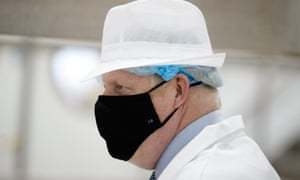 Boris Johnson wearing a face mask with ‘10’ branding on it in Scotland last week. Photograph: Robert Perry/PA
Boris Johnson wearing a face mask with ‘10’ branding on it in Scotland last week. Photograph: Robert Perry/PAUpdated at 10.21am BSTFacebookTwitter
The prime minister – who has previously been a prominent critic of state-backed measures to get people’s weight down – has claimed that the new “Better Health Strategy” would help people “not in an excessively bossy or nannying way”.
A video showing Boris Johnson walking the dog, to the strains of gentle classical music, has been posted on his twitter account, where he adds:
“We want this one really to be sympathetic to people, to understand the difficulties that people face with their weight, the struggles that everybody faces or many, many people face to lose weight, and just to be helpful.
Boris Johnson #StayAlert(@BorisJohnson)
Losing weight is hard but with some small changes we can all feel fitter and healthier.
If we all do our bit, we can reduce our health risks and protect ourselves against coronavirus – as well as taking pressure off the NHS.
Our Better Health Strategy https://t.co/WdazXhuhRN pic.twitter.com/KZhW8p17FJJuly 27, 2020
This looks fairly synchronised. The government’s obesity plans also got some backing from chef Jamie Oliver, a longtime campaigner against child obesity, who tweeted this at around the same time as the Johnson tweet came out:
Jamie Oliver(@jamieoliver)
.@BorisJohnson has #AdEnough & has committed to reducing how many junk food ads kids see on tv & online by introducing a 9pm watershed!
Big love to all of you who have supported our campaign. Let’s keep up the momentum so we can offer all kids a healthier and better future! pic.twitter.com/mdq9ESa9Q3July 27, 2020
Updated at 9.37am BSTFacebookTwitterAdvertisement
Here’s a quick look at how some of the morning newspapers treated the government’s announcement on travel Spain:

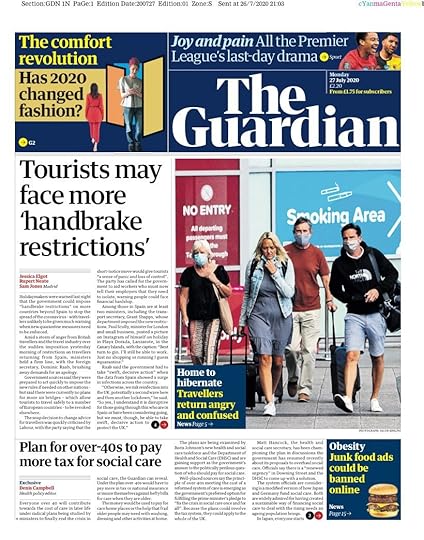


Ryanair has no plans to reduce flights to and from Spain
Ryanair will not reduce the number of flights to and from Spain, despite the British government’s decision to impose a 14-day quarantine on visitors returning from the country, which the airline’s chief financial officer called “regrettable,” reports Joanna Partridge.
The requirement for all travellers arriving in the UK from Spain to self-isolate for two weeks came into effect at midnight on Sunday, only hours after it was announced.
“I think it is regrettable, very disappointing,” Neil Sorahan told Reuters in an interview after the release of the Irish airline’s quarterly financial results.
Ryanair has not followed the lead of Tui, Europe’s biggest holiday company, which has cancelled all Britons’ holidays to mainland Spain up and including 9 August.
 A man stands at a Ryanair check-in desk at Josep Tarradellas Barcelona-El Prat airport. Photograph: Albert Gea/Reuters
A man stands at a Ryanair check-in desk at Josep Tarradellas Barcelona-El Prat airport. Photograph: Albert Gea/ReutersUpdated at 9.38am BSTFacebookTwitterAdvertisement
Travellers who are already there and those who were due to go on holiday in Spain this morning and the coming days have been airing their concerns on social media this morning, in some cases taking aim at the approach of individual companies.
sharryn walters(@sharrynlucywalt)
@Ryanair so all our extended families flights have been cancelled with @easyJet & @TUIUK for a big family holiday we were going on to Spain
July 26, 2020
Update: Xi Focus: Xi stresses further revitalizing northeast China
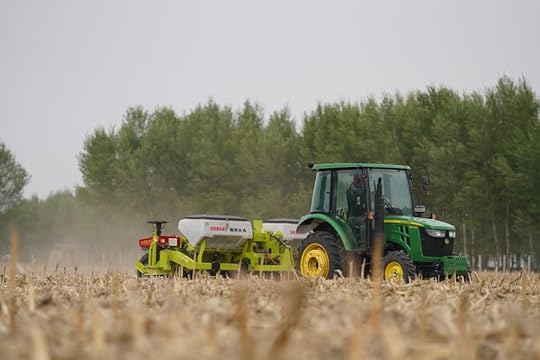
A farmer drives a no-till planter to seed corns in fields at Lishu County of Siping City, northeast China’s Jilin Province, May 7, 2020. (Xinhua/Zhang Nan)
CHANGCHUN, July 24 (Xinhua) — President Xi Jinping has stressed sticking to China’s new development philosophy and further implementing the strategy of revitalizing northeast China.
Xi, also general secretary of the Communist Party of China (CPC) Central Committee and chairman of the Central Military Commission, made the remarks during an inspection tour in northeast China’s Jilin Province from Wednesday to Friday.
He urged efforts to ensure a decisive victory in building a moderately prosperous society in all respects and eradicating poverty.
Xi underscored the great importance of China’s 14th five-year plan, which will start next year, as it is the first five-year period after the country embarks on a new journey to fully build itself into a modern socialist country.
Xi noted that the internal conditions and external environment for the country’s development are undergoing profound and complex changes.
“We must maintain sustained, healthy economic and social development,” Xi said, stressing the need to strengthen study and assessment, deepen research, and conduct sound policy-making.
Xi called for careful planning of the development goals, ideas and measures for the 14th five-year plan.
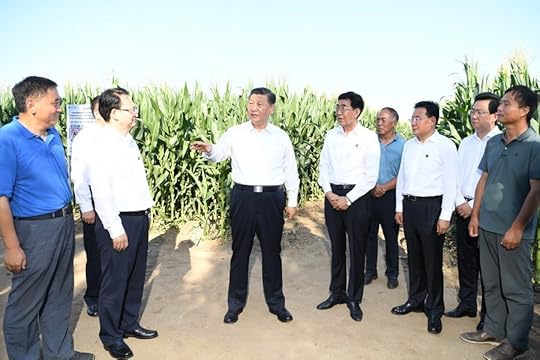
Chinese President Xi Jinping, also general secretary of the Communist Party of China Central Committee and chairman of the Central Military Commission, learns about grain production, the protection and use of black soil at a demonstration zone for green food production in Lishu County of Siping City, northeast China’s Jilin Province, July 22, 2020. Xi Jinping inspected Jilin Province on Wednesday. (Xinhua/Yan Yan)
Visiting Lishu County Wednesday afternoon, Xi was briefed on agricultural development and mechanized and large-scale farming.
“I care very much about grain production and food security,” Xi said, demanding that Jilin should make efforts to ensure food security, accelerate the transformation of agricultural development, and provide more experience in developing modern agriculture.
Walking into a cornfield, Xi stressed the integration of agriculture and technology, noting that farmers should be able to use the best technology to grow top-quality grains.
He also demanded effective measures to protect and utilize the high-yielding black soil.
Support should be given to new types of agricultural businesses such as family farms and farmers’ cooperatives, Xi said during a visit to a farmers’ cooperative, encouraging the development of specialized cooperatives suited to local conditions across the country.
During a visit to the memorial hall for the Siping battle of the Chinese People’s War of Liberation, Xi demanded efforts to earnestly study the history of the CPC and that of New China, uphold the great socialist cause founded by the Party and the people under the Party’s leadership, and carry the cause forward from generation to generation.
On Thursday afternoon, Xi inspected a residential community in the provincial capital Changchun to learn about primary-level governance and community services.
He spoke of the importance of improving community governance in promoting the modernization of China’s system and capacity for governance.
Xi also toured a planning exhibition hall of Changchun New Area, stressing the importance of infrastructure planning and construction, as well as better-connected industry and supply chains for high-tech development zones, so that they can play leading roles in boosting regional economic development.
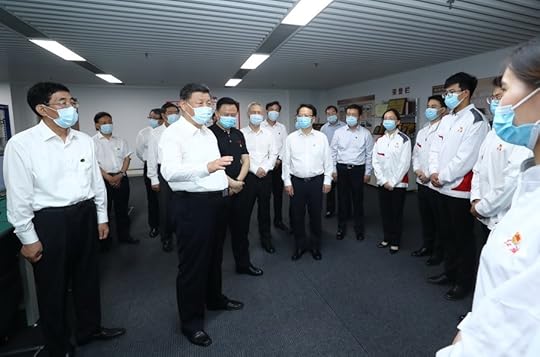
Chinese President Xi Jinping, also general secretary of the Communist Party of China Central Committee and chairman of the Central Military Commission, learns about the reform and development of state-owned enterprises at the R&D headquarters of automaker FAW Group in Changchun, northeast China’s Jilin Province, July 23, 2020. Xi Jinping on Thursday inspected Changchun, the capital city of Jilin Province. (Xinhua/Ju Peng)
While visiting the R&D headquarters of automaker FAW Group, Xi chatted with employees who have recently graduated from universities. He said the Party committees and governments at all levels should pay very close attention to the employment of college graduates.
In the automaker’s exhibition hall, Xi learned about the company’s development and its latest automobile products.
Xi highlighted strengthening the independent development of core technologies and components to promote the high-quality development of China’s automobile manufacturing industry and build strong domestic automobile brands.
Noting the fierce competition in the global manufacturing industry, Xi called for vigorous efforts to advance the development of emerging industries with strategic importance.
On Friday morning, after hearing the provincial Party committee and the provincial government of Jilin report their work, Xi affirmed the accomplishments made by Jilin and encouraged the officials and people of the province to achieve more.
To promote high-quality economic development, efforts must be made to strengthen the competitiveness of the economy, as well as its capabilities to innovate and fend off risks, Xi noted.
Xi stressed efforts to develop the real economy, especially the manufacturing industry, to upgrade the whole industrial chain and to stimulate the vitality of various market entities.
Xi encouraged Jilin to actively participate in the Belt and Road Initiative, and to develop itself as a major window for northward opening up and a hub for cooperation in Northeast Asia.
Xi urged efforts to consolidate the position of agriculture as the foundation of the economy and deepen rural reforms, as well as to develop family farms and farmers’ cooperatives and new forms of the collective economy.
He also called for consolidating the achievements in poverty relief and preventing relapses into poverty and new poverty cases, as well as the effective implementation of major ecological projects.
Xi stressed giving priority to employment for key groups, including college graduates, demobilized military personnel, rural migrant workers, and urban residents who have difficulty finding jobs.
Efforts are needed to promote the integrated and balanced development of compulsory education in urban and rural areas and safeguard fairness in education, he said.
Xi demanded efforts to improve the system and mechanisms for the prevention, control and treatment of major epidemics.
He also underlined flood control and relief work.
Efforts should be made to consolidate, develop and give full play to the Party’s organizational advantages, Xi said, stressing fully strengthening primary-level Party organizations and exercising full and rigorous governance over the Party.
Source: Xinhua
July 25, 2020
Any pilot targeted will be compensated through contribution: ICPA
IANS | New Delhi | July 25, 2020 2:13 pm
“It has been hereby resolved by the CEC of the ICPA that if any pilot/s, irrespective of the grade, is targeted by the management, the affected pilot/s will be financially compensated by way of equal contribution,” the ICPA resolution said.
“The said compensation will be either the last drawn pay or immediate senior’s pay, whichever is higher. The compensation payout will continue till such time the affected pilot/s are reinstated or employed as a pilot. Legal expense, if any, will also be covered by the ICPA. This resolution will be in force for a period of five years with immediate effect,” the ICPA said.
The ICPA has been raising several issues with the Air India management on the pay cut issue.
Air India pilots have told the management that while austerity measures are heaped on the pilots, the senior officials and management are enjoying lavish perks like free club memberships, scores of leased cars and hundreds of litres of free fuel every month, and there has been no cutback.
In a letter to Rajiv Bansal, Chairman and Managing Director, Air India, the pilots’ associations said, “It is not only unprincipled for the senior officials to exclude their perks, eligibilities and entitlements from the austerity measures, but also irrefutable proof that the intent of the management’s cost cutting measures is to further the agenda of abusing employees under the guise of this epidemic.”
In a letter, the Indian Commercial Pilots’ Association and the Indian Pilots’ Guild said that for the past few months, it is being said that Air India’s finances are in dire straits, there is no money coming in from the government and drastic cost-cutting is required else the airline will have to shut down.
“However, this doomsaying seems to be reserved for pilots alone. Till date, the management is yet to come up with a meaningful austerity measure that even dents the perks and privileges being enjoyed by the senior Air India officials,” the letter said.
The pilots said that the factors of redundancy and efficiency as per the compulsory leave without pay scheme should first apply to the officials of the senior management from 2016, who are directly responsible for the bungled decision making that has seen Air India’s losses mount year after year.Read More
Source: The Statesman
July 24, 2020
India, China set for more talks to de-escalate Himalayan standoff
NEW DELHI (Reuters) – Indian and Chinese diplomats were set for more talks on Friday to narrow differences on ways to pull back troops eye-balling each other across a disputed border in the western Himalayas, where 20 Indian soldiers died in a clash over a month ago.
FILE PHOTO: An Indian Army convoy moves along a highway leading to Ladakh, at Gagangeer in Kashmir’s Ganderbal district on June 18, 2020. REUTERS/Danish Ismail/File Photo
There were no shots fired during the June 15 fighting in the Galwan Valley of India’s Ladakh region when the Indian soldiers were beaten with rocks and clubs, but it still marked the worst clash in decades between Asia’s nuclear-armed giants.
Since then the two sides have held several rounds of talks to restore calm, and reduced the numbers of troops in the valley, while still pouring reinforcements into the region.
Once they agree how to sequence a pull back from frontline positions, the next step would be for the withdrawal of all the additional forces and military equipment that were deployed in rear areas after the clash.
Diplomats from both sides were set to hold talks through a virtual meeting of the Working Mechanism for Consultation & Coordination on India-China Border Affairs, a government source in New Delhi said.
The de facto border, called the Line of Actual Control (LAC), was established after a war in 1962, but it remains poorly defined, and there have been sporadic flare ups over the decades, without leading to cross-border firing.
India’s foreign ministry spokesman Anurag Srivastava said maintenance of peace on the border was the basis of bi-lateral relations.
“Therefore, it is our expectation that the Chinese side will sincerely work with us for complete disengagement and de-escalation and full restoration of peace and tranquillity in the border areas at the earliest,” Srivastava said.
A U.S. official, speaking on the condition of anonymity, told Reuters in Washington that the United States had seen a build-up of forces on the India-China border, estimating that each side had over 10,000 troops in the border area.
“We’re still seeing actually troop reinforcements and weapon reinforcements moving towards the border. So by no means are we out of the woods yet,” the official added.
India has also taken non-military retaliatory action against China after last month’s clash.
On Thursday, New Delhi said companies from neighbouring countries bidding for government contracts would need to register and obtain security clearance.
Citing security concerns, India has outlawed 59 apps of Chinese origin, including ByteDance’s TikTok and Alibaba’s UC Browser.
Source: Reuters
July 23, 2020
India to offer production linked incentives to boost manufacturing
NEW DELHI (Reuters) – India is working on offering production linked incentives for up to five sectors to boost domestic manufacturing, a top finance ministry official said on Thursday, bolstering efforts to attract new investments in the coronavirus-stricken economy.
FILE PHOTO: Labourers work at the manufacturing plant of Oppo, which is under construction, in Greater Noida, India, October 22, 2018. REUTERS/Anushree Fadnavis
Asia’s third-largest economy is expected to contract by as much as 10% in the current fiscal year beginning April, some private economists’ estimate, after the outbreak crippled business and consumer activity since late March, compared to government’s earlier target of about 6% growth.
The government has announced a raft of measures including direct food subsidy to nearly 810 million people and credit guarantees of 3 trillion rupees (31.59 billion pounds) on loans to small businesses.
Tarun Bajaj, economic affairs secretary at the Ministry of Finance, told a virtual conference that incentives would be offered to sectors to push manufacturing and help struggling industries.
Bajaj didn’t specify the sectors that may be eligible for incentives.
The government earlier announced production linked incentives for large scale electronic goods makers for five years, to attract investments in mobile phone manufacturing and electronic component units.
Incentives have also been announced for pharmaceutical companies for production of bulk drugs and on medical devices.
Speaking at a virtual conference organised by the Federation of Indian Chambers of Commerce and Industry (FICCI) on Thursday, finance ministry official said the government was expecting a “V” shape economic recovery beginning next fiscal year.
Reuters earlier reported that India is drawing up an incentive scheme for the autos sector aimed at doubling exports of vehicles and components in the next five years.
Industry and government sources said sectors such as textile and food processing manufacturers could be offered production linked incentives.
The latest data on 14-15 economic indicators including railway freight and tax collections showed a pick up in economic activities, Bajaj said, adding the government was open to borrow more from the market to meet spending targets for infrastructure projects.
Source: Reuters





